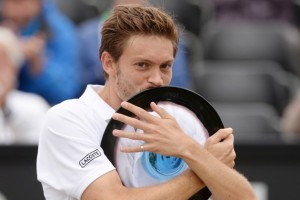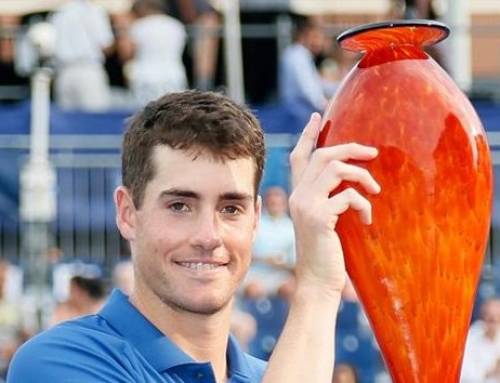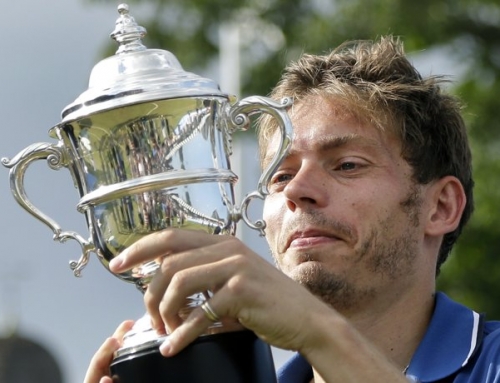 What do Roger Federer, Jurgen Melzer, Gael Monfils, and Nicolas Mahut have in common? It’s a toughie. Three of the four players listed have reached the semifinals of a Slam, and of course, in Roger Federer’s case, he’s won 17 Slams. Mahut, however, seems to be the odd man out.
What do Roger Federer, Jurgen Melzer, Gael Monfils, and Nicolas Mahut have in common? It’s a toughie. Three of the four players listed have reached the semifinals of a Slam, and of course, in Roger Federer’s case, he’s won 17 Slams. Mahut, however, seems to be the odd man out.
The answer? All four have won junior Wimbledon. Indeed, Federer, Melzer, and Mahut won the title in consecutive years with Federer in 1998, Melzer in 1999, and Mahut in 2000. Winning a junior Slam is no guarantee of success. Indeed, who has heard of the winners between Mahut and Monfils? In 2001, Roman Valent won, then Todd Reid, then Florin Mergea. 2004 becomes the first year a player has won Wimbledon juniors that you’ve heard of, namely, Gael Monfils.
Had it not been for the marathon match in 2010 between Isner and Mahut, you may never have heard of the Frenchman. That match, which lasted some 11 hours, stretched over 3 days, and ended in a 70-68 fifth set, the longest in history, by far. It was a perfect storm of a match with Isner having such a huge serve that Mahut struggled to return and Isner being so fatigued that he sometimes didn’t try to return serve. And, in any case, Mahut was an accomplished grass court player–it’s still his best surface.
The two were inextricably linked, and had the “1 in a million” chance (it’s less than that, but whatever) of meeting in the first round of the 2011 Wimbledon. The big difference between 2011 and 2010 was the relative rankings. In 2010, Isner has been seeded while Mahut had to qualify, and barely got out of qualifying. He needed a 24-22 third set to beat Brit Alex Bogdanovic in the second round of qualifying, then he was pushed to 5 sets in the final round of qualifying. In 2011, Isner’s ranking had slipped and he was unseeded, but Mahut’s ranking had gone up, and so he was in the main draw.
Unlike 2010, that was a straight set win. 2012’s draw was nearly just as unlikely. Isner and Mahut were scheduled to meet in the second round. Isner was seeded 11th, but lost in a tough 5 setter to Alejandro Falla. Mahut was also pushed to five sets by the Italian, Paolo Lorenzi, but he won, and made it to the second round, but lost in 5 sets to Falla. Two years earlier, during the Isner-Mahut marathon, Falla had pushed Federer to a 5-set opener, nearly upsetting the great Swiss.
2013 had seen Mahut’s ranking slipped due to injury down to 240, much lower than he had been ranked in any of the Wimbledons in the previous few years.
He was about to reach his biggest moment in this year’s French Open. Paired with Michael Llodra, the two of them reached the finals of the French Open in doubles where they met the Bryan brothers. The Bryan brothers have won a career Slam in doubles, but clay was clearly the weakest surface for the brothers having only one won French Open in their career up to this point. The two teams were evenly matched and played a third set tiebreak. The French team got up early in the tiebreak, but Mahut made a series of errors, and eventually the tiebreak went the way of the Americans who profusely thanked the French team, and said they were lucky. Meanwhile, this was Mahut’s best chance to do something meaningful in his life, and he had blown it. Mahut, aged 31, was in tears and seemed inconsolable.
Little would Mahut know that s’Hertogenbosch would serve as redemption. Mahut had to go through qualifying just to get into the main draw, being ranked 240 in the world. Fortunately, tournaments held just before Slams generally have weak draws, and in any case, Mahut was even seeded as a qualifier. Then, he beat Ricardas Berankis, one of those players that occasionally get mentioned with Dimitrov and Tomic, in the opening round. Then, a straight set win over Andrey Kuznetzov, then a straight set win over Evgeny Donskoy, then a straight set win over Xavier Malisse, one of the few players comparable in age to Mahut.
In the finals, he would play Stan Wawrinka. Wawrinka’s best surface is clay, and he does well on hard courts. Grass is decently good for Wawrinka, but maybe his weakest surface. Even so, he would be considered a favorite to beat Mahut, but that was not the case as Mahut won in straight sets, 63 64, to become one of the lowest ranked player to ever win a title. Mahut broke down, but this time in joy. After toiling on the tour for more than a decade, mostly as a doubles specialist, and having reached only 2 finals prior to this (both losses), the last time in 2007, Mahut could finally raise the trophy as a winner. And, for his part, Wawrinka mostly speaks French, so he and Mahut have become good friends on tour.
Eastbourne
Across the pond in England, Gilles Simon was to face Feliciano Lopez. Of the two, Lopez is the more accomplished grass court player, but Simon has been having a pretty good year, the best since his breakout in 2008. Outside of Nadal, Lopez might be the best Spanish player on grass, and, in any case, it is probably his preferred surface, unusual given his Spanish heritage. But with a big lefty serve, and slice backhand, he is like the Spanish Michael Llodra, though less accomplished at net, and probably more accomplished from the baseline.
This was a tight match for two sets with Lopez taking the first set in a tiebreak, then Simon taking the second in a tiebreak, before Lopez broke open the match and took the third set at love.
Ivan Ljubicic, former top ten player from Croatia, tweeted that the two players, Simon and Lopez, despite having been on tour for a decade, had only played each other once, prior to today’s match, and now, given their encounter in the finals and the Wimbledon bouncy balls which placed them as first round opponents, are going to play twice in a matter of days.
Lopez said he was thrilled to win because he had considered not playing due to an injury. This is Lopez’s third career title, his first since 2010, and his first on grass. Like Mahut, Lopez is also 31 years old.



![[Stockholm] Dimitrov wins first ATP title with 3-set victory over Ferrer](https://www.essentialtennis.com/wp-content/uploads/2013/10/20131021grigor-500x383.jpg)
![[Metz/St. Petersburg] Simon and Gulbis are champions!](https://www.essentialtennis.com/wp-content/uploads/2013/09/20130922gulbis-500x383.jpg)

